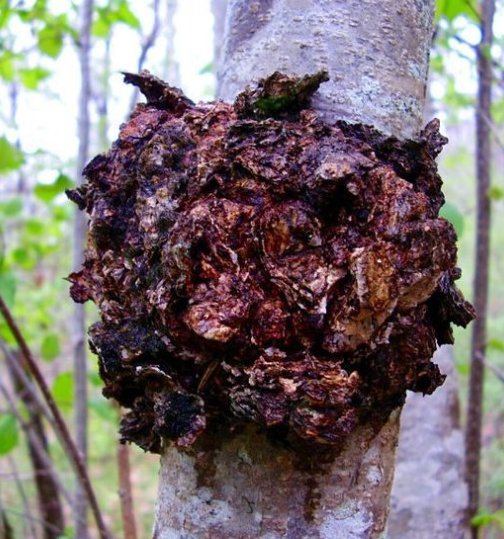WHAT IS CHAGA FUNGUS?
Chaga (Inonotus obliquus) is a sterile conk fungus that grows primarily on birch trees.
It is also referred to as the King of Medicinal Mushrooms (though it is a mycelium mass and not technically a mushroom), clinker fungus, and tinder conk (for its high flammability and long, slow smolder).
The fungus forms a parasitic relationship with the birch tree that can last decades, wherein the chaga grows slowly, surviving off the tree’s nutrients.
You may also hear the birch-chaga relationship referred to as symbiotic or mutualistic, because some claim the fungus actually aids the tree by enhancing its immune system and healing it from external damage.
Still, the fungus will eventually kill the birch tree, though they can live together for many years.
This disagreement about the chaga-birch relationship is only one example of the variability in definitive information currently available about chaga, at least to a general audience.
Though it has been featured in Eastern medicine for centuries and has been studied for the last 50 years or more in regions such as China, Siberia, and Northern Europe, research performed with actual human subjects is scarce.
The bank of knowledge may continue to grow, however, as chaga gains widespread attention for its healing potential.
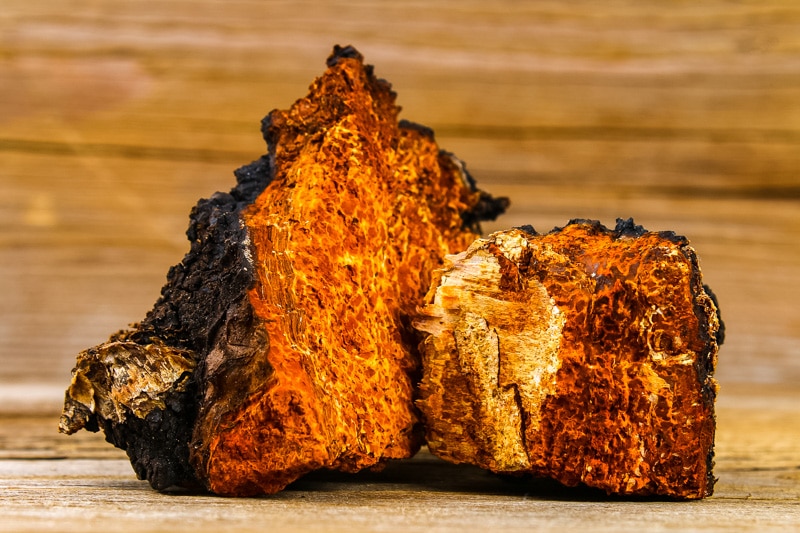
Chaga Benefits
If you read up on chaga, you will find a variety of claims about its health benefits. Some have been tested in clinical studies (though often not on humans), while others have not.
Many that are tested have broad limitations in the study’s scope. Therefore we can’t draw firm conclusions about how chaga might treat or cure certain health problems.
This doesn’t mean you shouldn’t try chaga and learn how it works for you, but use common sense and avoid seeing chaga as a “cure-all” for anything that ails you.
These are some of the enticing benefits people associate with chaga:
- Anti-inflammatory for colitis and other inflammatory bowl disease
- Anti-aging for skin
- Antibacterial
- Anticancer and antitumor, including some lung and liver cancers
- Antioxidant
- Good source of various vitamins and minerals
- Cholesterol regulation
- Blood sugar regulation
Foraging & Identifying Chaga
Look for this marvelous fungus in late fall and all throughout the winter, until spring’s warmth causes the birch sap to flow.
Though chaga is present year-round, some people insist that the colder months are the best time to forage chaga because the birch is dormant and there is more energy stored in the chaga.
When the sap begins to flow, the chaga may retain more water, reducing the nutrient concentration.
Another good reason to harvest chaga in the winter is the lack of foliage in deciduous forests, making it easier to spot chaga up in a tree.
Since the chaga fungus grows primarily on birch trees, focus your attention on finding mature birches, which will likely grow in well-drained soil near water, with access to sunlight.
Be sure to only take chaga from living birch trees, because the fungus dies when the tree dies. You definitely don’t want to consume dead or rotting chaga. Yuck!
Because of its blackened exterior, it is easy to mistake a chunk of chaga for a burnt or rotting piece of the tree.
People also mistake burls for masses of chaga, because they both protrude considerably from the tree’s bark, and some burls can have a dark exterior like chaga.
Once you know what to look for, however, you shouldn’t have much trouble identifying chaga and telling it apart from the look-alikes.
The bottom-line in foraging chaga is to be informed by doing your research before you head out in search of the fungus.
This will reduce your likelihood of accidentally harvesting something that isn’t chaga, or harvesting the chaga inappropriately.
Harvesting Chaga Sustainably
Speaking of inappropriate removal, chaga is particularly vulnerable to overharvesting. Because it grows slowly and has health benefits, chaga is a prime candidate for becoming quickly depleted.
If you live in an area with access to chaga, practice ethical foraging principles by taking only what you need and leaving enough chaga behind so that it can regrow and continue thriving.
The slow-growing chaga takes years to reach maturity and develop spores for reproduction. To give chaga enough time to reproduce before you disturb it, only harvest from fungal masses that are larger than a grapefruit.
Opinions differ on how much of the fungus to take at one time. A good rule of thumb is to leave at least ⅓-½ of the chaga intact and connected to the tree.
In addition, only take that much if you have solid plans for properly storing and/or promptly using all of the chaga. Never take the entire chaga mass, and avoid cutting into the tree.
The chaga will be quite hard, and you will need a sharp, sturdy tool to break into the fungus. Some people use a hatchet, while others use a small saw, hammer and chisel, or even a very strong knife.
Regardless, be ready to sweat a bit!
Once you penetrate the dark exterior, the chaga’s interior should be a lighter brown-orange color.
Chaga can rot and mold easily, so when you get home be sure to dry it out by leaving it on a baking sheet near a woodstove or other heat source. Don’t bake it in the oven.
source: https://www.growforagecookferment.com/harvesting-chaga/
Chaga Mushroom Questions (And Answers) – (FAQ)
![]() Written by: Rick Benson
Written by: Rick Benson

There are many Chaga related questions online, and interestingly, many of them are left unanswered! We searched the web for questions in order to provide you with answers. If you have more questions, feel free to ask them below. We will try to answer them.
What Is Chaga (Mushroom)?
Chaga mushroom is a fungus that grows on birch trees. It is proven to be a very healthy superfood, full of antioxidants. It is also known as Chaga mushroom, Chaga mushroom fungus, Siberian Chaga, wild Chaga, Russian Chaga, Canada Chaga, Cinder conk, Birch conk, Clinker polypore and more.
What Is Chaga (Mushroom) Good For?
Chaga is good for preventing cancer and other diseases, caused by free radicals. There are other studies that cover the effects on different diseases. Chaga is also good for maintaining good health. To read more about the benefits of Chaga, click here.
What Does Chaga Do?
 Chaga loaded with healthy anti-oxidants that neutralize harmful free radicals. Free radicals are produced in our body during normal metabolism, but they are highly reactive chemicals that cause damage to DNA, and accelerate aging. Free radicals can be neutralized with antioxidants. That’s why it’s important to eat fruits and other foods full of anti-oxidants. Antioxidant levels are measured on the Oxygen radical absorbance capacity (ORAC) scale. Chaga measures very high on this scale.
Chaga loaded with healthy anti-oxidants that neutralize harmful free radicals. Free radicals are produced in our body during normal metabolism, but they are highly reactive chemicals that cause damage to DNA, and accelerate aging. Free radicals can be neutralized with antioxidants. That’s why it’s important to eat fruits and other foods full of anti-oxidants. Antioxidant levels are measured on the Oxygen radical absorbance capacity (ORAC) scale. Chaga measures very high on this scale.
Is Chaga Safe?
Chaga is safe and has no narcotic effect. However, to be on the safe side, especially if you are frail, or have an autoimmune disease, you should check into side-effects to make sure it’s right for you. It may interact with certain drugs, especially blood thinners and insulin.
What Is Chaga Used For
Chaga has been used for centuries for preventing and treating diseases. The most popular is the ability to prevent cancer. Chaga kills cancer cells in studies with mice, and in tissue cultures. Today, Chaga is used in tea, coffee, and in other different recipes. Chaga is used to improve your body’s health and vitality.
What Does Chaga Look Like / How To Identify Chaga

Chaga vs Birch Gnarl
Chaga is black on the outside with a very hard and crispy shell, and golden-yellow-brown on the. It is hard both inside and out. The cell walls are made of very hard chitin.
The shapes can vary widely from cone to horn or heart. It is often confused with birch gnarl, which isn’t actually a virus. Chaga is fairly easy to remove.
You can do it by hand, with a knife, ax or club. The cut edge should be golden-yellow-brown. Birch gnarl, on the other hand, requires a saw to remove woody part of the tree.
However, they are clearly distinguishable. Chaga mushroom is the only thing growing on birch trees and always has it’s hard, crusty, black exterior, and a golden-yellow-brown inner structure.
Chaga’s flavor and smell might be slightly earthly but some people detect no flavor or smell.
If you’ve seen Chaga mushroom pictures, you quickly realize that there aren’t similar species to it. The most similar looking thing that might be confused with Chaga is birch gnarl. But birch gnarl is pretty different and from the inside; it doesn’t have Chaga’s colors, and it is a wooden section of the tree.
How To Find Chaga
You can find Chaga during any hike in a northern deciduous forest. Look for birch trees. If you want to find Chaga, keep in mind that it’s neither rare nor common. It will take some time as you walk through different forests.
What Trees Does Chaga Grow On
Chaga grows typically on birch trees (all species), but it is also found on elm, beech and hornbeam. It typically grows between 2 and 10 feet from the ground. Chaga is parasitic on birch and eventually kills the host tree.
What Color Is Chaga?
There aren’t color differences in Chaga. It is always black on the outside with a crispy and extra hard structure. From the inside, it is golden–brown–yellow–orange. If you remove the Chaga fungus from tree, you’ll see the same color at the cut edge. The colors remain the same when dried.
How Big Can Chaga Get?
 Chaga can be from 1″ as it starts to grow to huge – over 1ft in diameter. The growth rate depends on conditions, but generally, it takes about 5 years to get to 10″ in diameter, so growth is rather slow. If you find Chaga fungus smaller than an apple, let it grow – come back and pick it later when it’s ready.
Chaga can be from 1″ as it starts to grow to huge – over 1ft in diameter. The growth rate depends on conditions, but generally, it takes about 5 years to get to 10″ in diameter, so growth is rather slow. If you find Chaga fungus smaller than an apple, let it grow – come back and pick it later when it’s ready.
What Does Chaga Taste Like?
The Chaga taste depends on the person, how it has been prepared, how dry it is, and the recipe you use. The taste varies from neutral to an earthy taste. If used in coffee, the coffee will overpower Chaga’s neutral taste. When using on tea, it gives a woody or earthy – mushroom taste. The tincture extract, on the other hand, gives a much stronger alcohol taste.
This flavor is one of the reasons that it’s a much-loved superfood – it doesn’t dominate other flavors. Most people find the taste mild, interesting and pleasant.
What Does Chaga Consist Of?
Chaga consist of
- Water 13.2%
- Proteins 2.40%
- Lipids 2.40%
- Ash 1%
- Carbohydrates 71.9 % (lignin 32.6%; beta-glucans 12.0%)
- Ergosterol
- K 2.98%
- Na 0.02%
- Ca 0.06%
- Mn* (Percentage wasn’t specified, but estimated to be around 110ppm)
The total energy is 159.4 kcal/100 g
Keep in mind, the carbohydrates make the Chaga the real superfood. In combination, you’ll get a very powerful anti-oxidant – the Chaga.
Where Can I Get Chaga? / Where To Find Chaga (Mushroom)
There are two main ways – harvesting it yourself or buying online. Chaga is a fungus that typically grows on birches. However, some online sites sell Chaga, that isn’t naturally grown. That’s a reason to harvest it yourself so that you be absolutely sure of its quality.
When To Harvest Chaga
 Ways, how to remove chaga
Ways, how to remove chaga
There is some information on the internet that specifies a very strict time of year for the harvest. That just isn’t correct, because you can do it all year round. The Chaga mushroom removal doesn’t affect the tree regardless of the time of the year.
How To Harvest Chaga
Anyone can harvest Chaga. It grows on birches all over the world. The shape of Chaga can be any shape that you can imagine, from cone to horns or forming the shape of a heart, a ball etc…
You can use an ax, knife, or your hands or whatever is convenient to force the mushroom from the tree.
Chaga Preparing & Storing Questions
How To Use Chaga
Chaga can be used in many different ways. The most popular way is to use it in tea. To wrap it up – you need to dry it so that you can grind it into a powder. Powdered Chaga is the most versatile form, and can be used any way you prefer – from tinctures to ice-teas.
How To Prepare / Process Chaga For Consumption
 There are many ways to prepare Chaga for consumption. Keep in mind that heat is needed to crack the strong chitin cell walls, to release the healthy ingredients. The most popular way to process Chaga for consumption is with a double extraction. This means that simmer it in hot water several times.
There are many ways to prepare Chaga for consumption. Keep in mind that heat is needed to crack the strong chitin cell walls, to release the healthy ingredients. The most popular way to process Chaga for consumption is with a double extraction. This means that simmer it in hot water several times.
How To Dry Chaga
Before you can use Chaga, you need to dry it. The best way is to cut it into pieces 1″ – 2″ in diameter. Lay the Chaga chunks on newspaper, somewhere where they can dry. The drying process should take from 1-2 months.
There is also a faster method when you put them overnight in an oven at 60o C. Then the water comes out and your Chaga is ready to use for the next process.
How To Store Chaga (Chunks)
Chaga isn’t fussy – once it’s ready, you can use it however you want. However, if you don’t want to store it in a damp place, because you don’t want humidity to get back into the Chaga. So you might want to store your Chaga in glass or in a cardboard box in a dry place, away from sunlight.
If you want Chaga to be ready for quick consumption, you need to prepare either a tincture extract or powder. These formulations are always ready to use.Chaga isn’t fussy – once it’s ready, you can use it however you want.
Chaga Recipe Questions
What Are The Best Chaga Recipes
 The Chaga recipes are up to you – go ahead and practice. There are some on the internet, and we have covered our favorites here. However, you can add it to almost anything – it doesn’t dominate other flavors, but makes any food or drink more healthy.
The Chaga recipes are up to you – go ahead and practice. There are some on the internet, and we have covered our favorites here. However, you can add it to almost anything – it doesn’t dominate other flavors, but makes any food or drink more healthy.
How To Make Chaga Skin Cream
To be honest – We don’t know. We haven’t done it and don’t want to just copy recipes online, because our work comes from our experience. The recipes we have seen simply put some Chaga into skin cream.
How To Make Chaga Extract
Chaga extract is the most popular thing one can do with Chaga. The difference between a tincture and an extract is that tincture is typically made from double extraction and therefore it has a higher concentration of ingredients. Making a tincture requires some patience.
How Can I Grow Chaga Mushroom?
 The short answer is – you cant! Unless you have a laboratory with lots of money to invest, and enough time to grow trees. Chaga grows wild on trees, especially on birch. There are factories where Chaga is grown, but the ingredients from this lab-grown Chagas are not the same as wildly grown Chaga.
The short answer is – you cant! Unless you have a laboratory with lots of money to invest, and enough time to grow trees. Chaga grows wild on trees, especially on birch. There are factories where Chaga is grown, but the ingredients from this lab-grown Chagas are not the same as wildly grown Chaga.
So, the best thing you can do is spot small Chagas, make note of them and watch them grow. This way you can grow Chaga mushrooms – and when ready, you can pick them yourself.
How Long Does It Take To Feel The Effects Of Chaga?
Unlike the instant effects of caffeine in coffee, you don’t feel any immediate effects from Chaga, other than the warm pleasant feeling you get from a cup of tea. The benefits accumulate slowly, with long-term use. There are no good studies that tell us how long it takes to see an effect. It’s hard to measure the exact time you didn’t get sick!
How Much Is Chaga Worth?
Chaga can sell for anywhere for $20 to $2,000 a pound. The price of Chaga fluctuates and depends on the processing and the quality. Raw Chaga is the cheapest, while tinctures, extracts and other formulations are more expensive because of the extra labor in processing, as well as the marketing of special formulations.
Can You Eat Chaga?
Yes, you can. There are no bad side-effects from eating raw Chaga. Small pieces of fresh raw Chaga found in the forest are good to chew. The taste of raw Chaga isn’t extraordinary. It’s got an interesting earthy-gummy structure.=
Should I Consume Chaga?
Of course! Start today if you can, and you’ll never go back to the days without it. Your body needs the benefits of Chaga to fight and prevent serious diseases including different cancers. There are several ways to consume it, but the easiest is to start drinking Chaga tea.
source: https://chaga101.com/chaga-faq/
9 Things You Didn't Know About Chaga
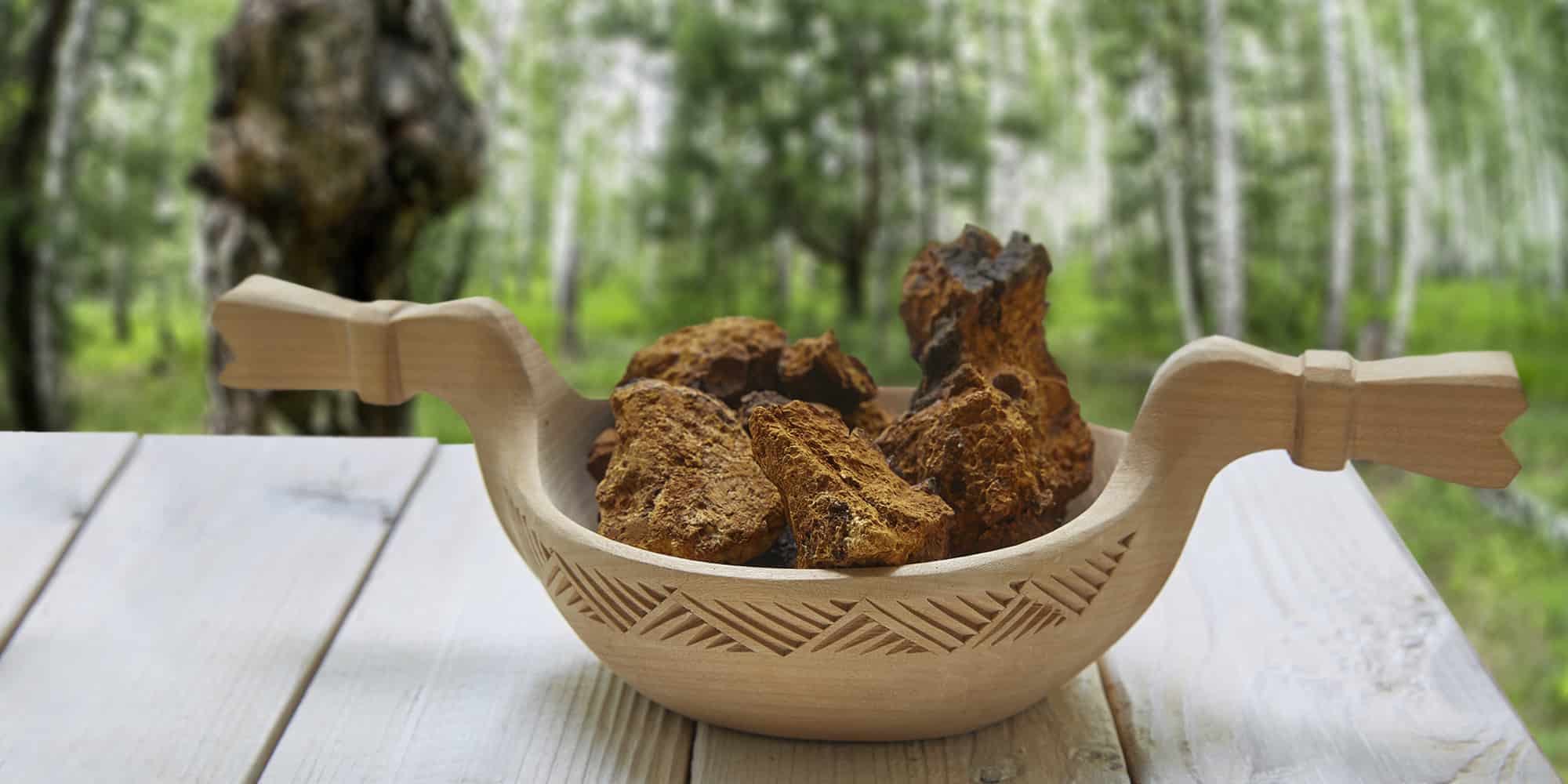
With plenty of articles out there touting the magic of chaga, we decided to focus on many of the unknown aspects or myths about it. What is Chaga? It is a very unique parasitic fungus, which is much different from the other mushrooms you know and love.
In the late 1990′s Chaga was virtually unknown as a dietary supplement, with the exception of Russia and a few countries in Southeast Asia. Now, in today’s world, many circles highly regard Chaga as a potent superfood.So let’s jump right in and reveal
9 Things You Didn't Know About Chaga
If you'd prefer to get your Chaga facts from the mouth of Real Mushrooms' Chief Funguy, Skye Chilton, take a look at the video below:
1. Chaga is not a mushroom
So, what exactly is Chaga, you ask?
Chaga is the common name for a perennial canker or sterile conk that commonly forms on a birch tree (Betula papyrifera, paper birch) after it has been infected and colonized by the mycelia of the pathogenic fungus Inonotus obliquus. The part of this fungus that one harvests is the outward manifestation of the fungal disease.
Common names for chaga include clinker polypore, cinder conk or birch canker polypore (not to be confused with birch polypore - Fomitopsis betulina). In British Columbia, Inonotus obliquus is classified as a tree disease.
How Chaga Grows:
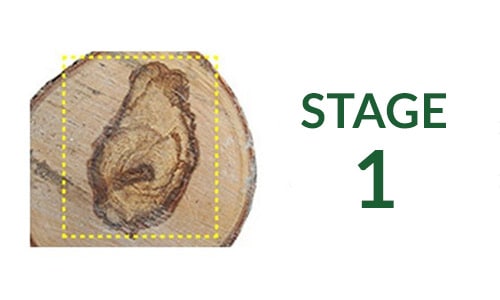 The spores have penetrated the birch tree, germinated, and have begun to consume the heartwood.
The spores have penetrated the birch tree, germinated, and have begun to consume the heartwood. 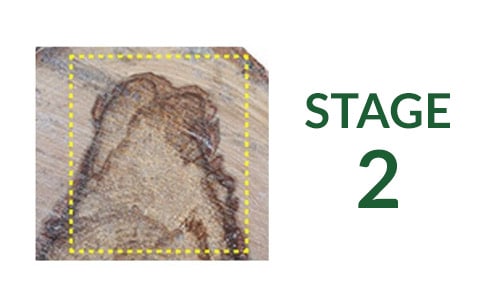 The fungus will then push toward the exterior of the tree consuming the wood as it goes.
The fungus will then push toward the exterior of the tree consuming the wood as it goes. 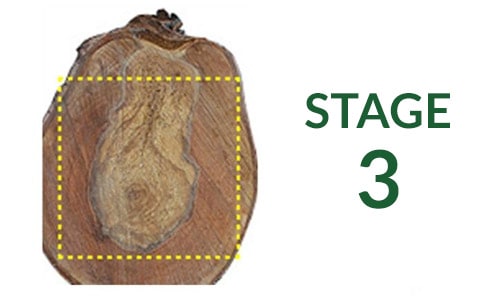 The fungus will break through the bark and begin to form the canker of mycelium and wood lignins we call "Chaga."
The fungus will break through the bark and begin to form the canker of mycelium and wood lignins we call "Chaga." 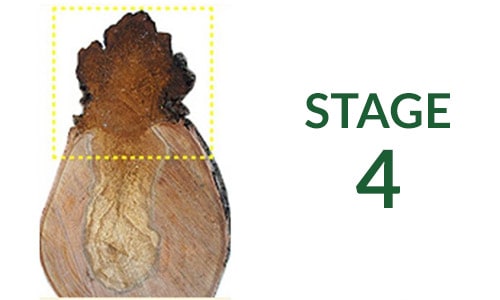 Over many years, the Chaga grows much bigger and darker. It largely contains wood fiber & lignin which house many of the nutrients found in the host tree.
Over many years, the Chaga grows much bigger and darker. It largely contains wood fiber & lignin which house many of the nutrients found in the host tree.
What we call ‘Chaga’ is the dense black mass that can be seen on the exterior of trees (almost exclusively on birch) infected with the fungus Inonotus obliquus. It's not a mushroom (fruiting body) but a dense sterile mass of decayed bits of birch tissue with mycelia incorporated.
When chopped from the tree the interior has a rusty yellow-brown color, somewhat granular in appearance, and is often mottled with whitish or cream-colored veins. Chaga can be referred to as a sclerotium, which is a dense mass of mycelium, but this is technically incorrect as Chaga is not pure mycelium.
One research paper estimated Chaga to be only around 10% mycelium based on microscopic observation. A more accurate term for Chaga is conk or canker or just plain old Chaga.
The exterior canker that is harvested should not be confused with the actual fertile fruiting body, which normally forms under the partially detached bark on dead standing or fallen trees. This fruiting body is a greyish, flat thin layered mass, up to 3-4 meters long and 40-50 cm wide, with downward cascading pores, which are the spore-producing layer of polypore fungi.
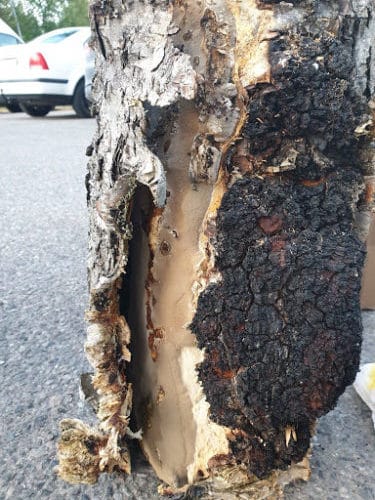 The bark has peeled away revealing the porous fruiting body. ©Terhi Joki, KÄÄPÄ Biotech, Finland.
The bark has peeled away revealing the porous fruiting body. ©Terhi Joki, KÄÄPÄ Biotech, Finland.
2. Chaga is primarily wood fiber and contains Birch compounds
Chaga is a slow-growing fungus that primarily grows on birch trees. It is common to find Chaga in the boreal forest regions of the Northern Hemisphere like in Russia, Korea, Eastern and Northern Europe, Northern areas of the United States and Alaska, Canada, and Northern China.
Typically, one finds well-developed Chaga sclerotia on trees over 40 years of age, but the infection starts earlier. The period from initial infection to tree death varies with the number of infection sites and tree resistance but is typically around 20 years. After about 3-5 years of growth, the Chaga can be harvested.
The harvested dark black conk consists primarily of wood lignans from the host tree and mycelium of the invasive fungus. Due to this, when Chaga grows on birch, it will also contain birch compounds like betulin and betulinic acid
After harvesting, Chaga can regrow to harvestable size again in three to ten years, and this can be repeated until the tree dies. Chopping off the Chaga does not kill the organism and the mycelium is still inside the tree slowly consuming it. Chaga is not technically a perennial by definition; it may live for years as it consumes its food source, but once that source is exhausted, it will then die for lack of nutrients.
3. Chaga has been used since the 16th century!
Russians have known about Chaga’s health benefits for a long time; the word ‘Chaga‘ is a derivative from ‘чага‘, which is the old Russian word for mushroom. A healing plant of renowned value throughout the world, Chaga is thought to be a potent immune-stimulating medicinal mushroom.
In fact, the first verifiable mentions of Chaga were from the early 16th century. Chaga is documented in folk and botanical medicine throughout Eastern Europe. Traditionally Chaga was used as a common remedy for stomach ailments.1
Chaga became popular in the West after it was mentioned in the book, Cancer Ward, by Nobel Prize-winning Russian author Aleksandr Solzhenitsyn. In the book, he notes that poorer people saved money on tea by brewing Chaga.
As early as 1955, a Chaga extract known as Befungin (Russian translation) has been sold in Russia to treat stomach and intestinal ailments.
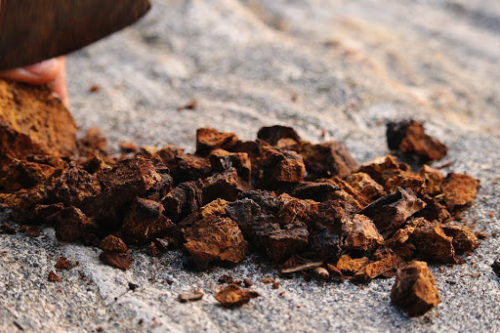 Smaller chunks of chaga cut from a larger piece.
Smaller chunks of chaga cut from a larger piece.
4. Chaga's outer crust contains melanin.
Chaga also contains melanin, concentrated in the black outer crust, which is a complex compound that gives the skin, hair and the iris (colored part of the eye) their color. Our skin naturally darkens in response to sun exposure which stimulates melanocytes to produce melanin. Considered a potent source of melanin, Chaga may help protect the skin and hair from sun damage. Melanins have a role in DNA repair, mitochondria health, cell metabolism, and protection from light and radiation. In particular, melanins from mushrooms exhibit a high anti-inflammatory effect based on their antioxidant and gene-protecting properties. Melanins can decrease oxidation of fatty acids and damage of membranes creating lots of potential for skin health.
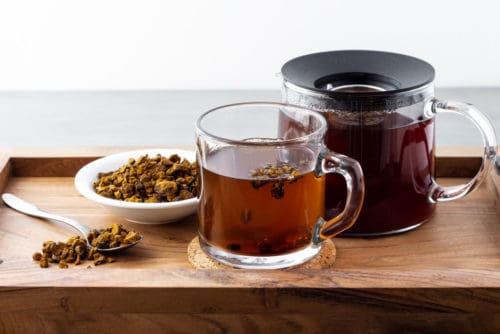 Tea made from boiling Chaga
Tea made from boiling Chaga
5. Chaga was a Finnish coffee substitute in WW2
Often, Chaga is compared to coffee with its robust flavor and dark color. It’s earthy, slightly bitter, and has a small hint of forest sweetness. Luckily, if you are sensitive to caffeine Chaga is a great alternative to coffee as it’s caffeine-free so it won’t keep you awake and it’s just as tasty!
In Finland, during WW2 there was a coffee shortage and substitutes started popping up, many based on roasted rye3. It was then that Chaga emerged as an ideal coffee substitute known as Tikka Te.
Chaga Coffee (which is really more like a tea) is a great and simple way to consume Chaga. You can buy the wild chunks from a reputable source to brew your own magical concoction.
But if you’re just looking for a quick and easy way to add Chaga to your diet, we’ve made it simpler for you to consume with our amazing Chaga capsules. We use a hot water extraction made from our pure source of wild-harvested Chaga from Siberia. Take two of these capsules daily over a three month period to feel the full health benefits.
6. Chaga Harvesting is Sustainable!
Many argue that wild harvesting of Chaga is not sustainable and we need to be wary of overconsumption of this fungi.
In 2004, David Pilz, Forestry Mycologist at Oregon State University, went to Russia to report on whether Chaga harvesting in Russia was sustainable or not.5 This is the most detailed report of Chaga harvesting currently available. The report determined that the “biological Chaga resource is immense, and unlikely to be over-harvested to the detriment of the species Inonotus obliquus any time in the near future.” According to the report, Chaga is excessively abundant, even with over-harvesting estimates.
The report states that Chaga infects upwards of 20% of all birch trees in Russia. This is in stark contrast to some claims on the internet that Chaga is extremely rare and only found on 1 in every 10,000-20,000 birch trees.
Similar to Russia, Scandinavia has vast boreal forests. Luke, The Natural Resources Institute Finland, estimates that Chaga infects 6-30% of all birch in Sweden and Finland.
Given similar estimates between Russia, Finland, and Sweden, it would be safe to assume that Canada also has vast amounts of Chaga in its boreal forest regions.
The Pilz report did make an important note about proximity to chaga. While the resource is vastly abundant, how far harvesters need to travel in order to find chaga will have a direct impact on the selling price. Popular harvesting areas may get over-harvested and lead people to believe that this fungus is threatened.
The Future of Chaga
In the future, there may be a tipping point at which the cost of harvesting becomes too expensive for supplements but given the vast amounts of Chaga available, this turning point would be well before there was any threat to the species itself.
An important note is that harvesting Chaga does not kill the organism itself. The mycelium is still inside the tree slowly consuming it. Near or after the tree’s death, the mycelium will begin to produce the mushroom (fruiting body) so that spores can be released and the organism can reproduce. Chaga harvesting does not impact the organism's ability to reproduce.
7. We rarely see the Chaga “Mushroom”
Since the harvested part of the Chaga is actually a woody canker and not a mushroom in the traditional sense, it begs the question: Does Chaga have a fruiting body?
Yes, it does but we rarely see it.
The actual mushroom (fruiting body) forms under the bark on dead standing or fallen trees. After the tree dies, the bark slowly separates from the tree, revealing the sporocarp (fruiting body). This fruiting body is a greyish, flat thin layered porous mass with downward cascading pores. When the conditions are correct, the pore layer will begin to release spores which will get blown around in the wind and eventually end up on a weakened birch tree and the infection process will start over. Insects also like to eat the mushroom which helps to transport the spores to new areas.
8. Lab grown Chaga is not Chaga!
Cultivated Chaga can and will have a different composition and therapeutic properties, depending on the conditions under which it grows (different types of substrate, environmental conditions, etc.)
This is because a lab can only cultivate the mycelium and not cultivate the canker or sclerotium itself.
Wild Chaga takes three to five years before it can be harvested and many of the special compounds in Chaga, like betulin and betulinic acid, come from the birch tree. If no birch tree is involved, like a lab-grown process, then none of these important birch compounds will be present. No black outer layer, no melanin. Not to mention that lab-grown Chaga is myceliated grain so there will be a large concentration of grain in the final product as opposed to the actual Chaga canker.
Luckily, our Siberian Chaga is wild-harvested and tested by 3rd party laboratories for the active compounds like beta-D-glucans that are quintessential nutrients for the immune system. This wild Chaga has been maturing for upwards of 20 years in the cold and wild boreal forests. Siberian Chaga contains many polysaccharides, triterpenoids, and melanin which is a pigment we need throughout the human body.
We care deeply about sourcing the highest quality mushrooms that contain the most medicinal compounds to support your health over long term use. It is recommended that adults take two capsules of our organic Chaga daily.
9. Chaga can be used to start fires
The bushcraft and survivalist communities use Chaga as a fire starter. Once dried, the inner brown section of chaga can take a spark and it is very slow burning making it ideal as starting coal for your fire. Fire pistons, which compresses air to create heat to ignite your starting coal, can also make use of Chaga.
In Summary
You’ve just learned that:
- Chaga is not a mushroom
- Chaga is primarily broken down woody tissue
- Uses of Chaga date back to the 16th century
- Chaga contains Melanin
- In World War 2 Chaga was a coffee replacement
- Chaga harvesting is sustainable
- We rarely see the Chaga “mushroom”
- Lab-grown chaga is not actually chaga
- Chaga can make fires
At Real Mushrooms, we pride ourselves on our product quality, as we know products on the market today aren’t always what they seem. We offer transparency with our sourcing, processing, and ingredients. We always use 100% mushroom extracts made with no grain or filler, created with ethics and purity, to assist in bringing optimum health to your life.
Terms of Use:The information presented on the network is intended to expand personal knowledge and provide general understanding in a variety of fields to help you be active your Creative freedom and nurturing your health. The information presented here does not pretend to be and is not a substitute for medical instructions. Everything presented on the network is the personal opinion of the writers and any decision regarding your action or health choice is your sole responsibility. with regards For complete inner freedom.
Outhematrix (out the matrix) Network management.



